|
|
|||||||||||||||||||||
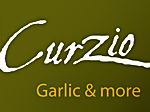 |
Shallots are my favorite onions - I like them raw in salads and cooked with green beans and other vegetables.
This variety is planted in the fall, like garlic, harvested in July and will store on your kitchen counter for 12 months!! |
||||||||||||||||||||
| On this page you will learn how I save seeds for this unique variety: French Winter Red Shallot. Plus you will find ongoing comparison with other varieties I'm growing and reoffering through Seed Savers Exchange.
NEW: Shallot F-1 hybrid seed is available from different seed catalogs. The debate is on!!! Are these new hybrids going to keep the proper propagation (aggregatum feature), or will STALK and go to seed? ... Stay tuned to find out.
|
|||||||||||||||||||||
| Select the best bulbs for planting
This onion grows in bunches. When you harvest shallots the bunch will easily come apart and you will be find onion bulbs that are larger and some are smaller. The larger bulbs actually contain several seeds that could be divided. I save the smaller bulbs to be planted with the skin, rather than dividing larger bulbs. |
|||||||||||||||||||||
| The bulbs on the right side are larger - you can clearly see how they could be divided in two - but under the skin you will find more seed to be divided with the risk of damaging the bulb as you divide it.
I prefer to save for seed the smaller bulbs on the left which is about the size of a quarter. You can easily tell which side is up and down! |
|||||||||||||||||||||
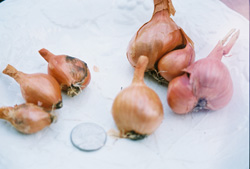 |
|||||||||||||||||||||
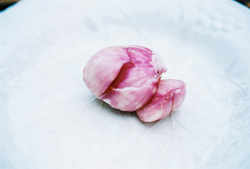 |
This picture shows a typical sized bulb with the skins removed. Through splitting you can grow three bunches from one bulb.
As I mentioned above, I prefer to save this size of bulbs for my kitchen. This bulb can be used for one large salad and 2 small tomato salads. |
||||||||||||||||||||
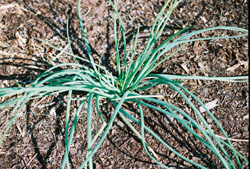 |
What's the best time for planting?
I've planted as late as mid November. But you must keep in mind that the bulb grows roots in the fall before the hard frost will kill the leaves. This picture shows a bulb that I missed to harvest in July and has resprouted at the end of September. |
||||||||||||||||||||
| The sooner you plant, the longer that bulb has a chance to establish a strong root system before the killing frost. I shall experiment with earlier dates (end of August and mid September vs. early October - my traditional garlic and shallots planting time). Results will be posted on this page. | |||||||||||||||||||||
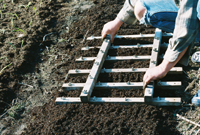 |
Seed spacing?
I use the same tool to mark the spacing for garlic, onions and shallots. |
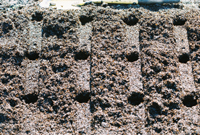 |
|||||||||||||||||||
| You can read more about my methods of planting onions on this web page. But for shallots I skip a spot. For instance on the picture on the right you can count 12 spots. Shallot seed would go in spot 1 - 3 - 6 - 8 - 9 and 11, so that horizontally each seed is spaced 12" apart and vertically the rows are spaced 6" apart. I can fit 60 bulbs in a row that is 15 ft by 2 ft. | |||||||||||||||||||||
| Chicken wire to stop squirrels
Squirrels don't like shallots but still enjoy pulling the bulbs to play. This is a picture taken in early January after a warm spell that melted the snow. In the spring I'll remove the chicken wire to facilitate the weeding. So far the temps were not low enough to kill the leaves. |
|||||||||||||||||||||
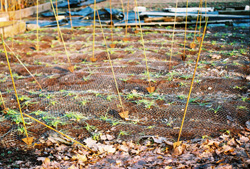 |
|||||||||||||||||||||
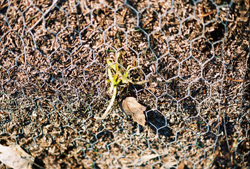 |
|||||||||||||||||||||
| Mid March - remove the chicken wire
The vegetation looked much worse in March when the snow has melted away. Here you can see a few sprouts that are just an inch long. Removing the chicken wire was an easy operation as the netting just rolled up. |
|||||||||||||||||||||
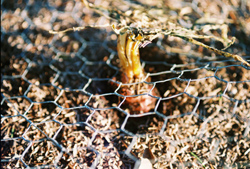 |
Chicken wire? A very BAD idea!!!
I found a few bulbs that may have been pulled up by the chicken wire in the thaw - freeze of the winter. Chicken wire amplifies the sun rays and protects from squirrel digging ... but has the wire protected more bulbs than I've lost due to the pulling during thaws? NO, I lost almost all the 2007 fall-planted crop! |
||||||||||||||||||||
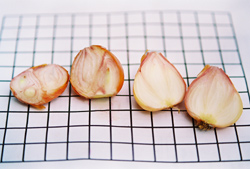 |
Comparing 2007 to 2008 bulbs
This picture shows how incredibly well this strain of shallots keeps (without refrigeration!). The picture was taken in early August 2008 with a bulb freshly harvested on the right, and a stored bulb harvested in August 2007. The 2008 bulb was planted in the spring 2008. This second picture was snapped in November as I was splitting bulbs to plant my winter crop (about half of my seed stock - in light of past losses, I now keep the majority of the seed for spring planting). Notice the darker color of the bulb on the right - that bulb was planted in 2007 and overwintered. |
||||||||||||||||||||
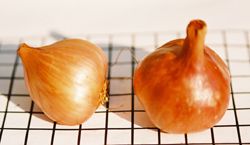 |
|||||||||||||||||||||
| I am strongly convinced that any crop that can be planted in the fall and overwinters, will likely develop a stronger root system and mine more minerals, thus developing a richer flavor and greater nutritional value. The darker red color may be a sign of greaterlevels of antioxidants.
Because weather and seasons have become so unreliable and unpredictable, I have for several years planted half of my crop in the fall and half in the spring. I recommend you do the same if you don't want to risk losing all your crop and seed. As the picture above documents ... you may even skip a whole growing season. I could have replanted a 2007 bulb in the fall of 2008 for harvest in 2009. Do you know of any other onion bulbs like this? Great news about 2008 - 09 overwintering. All my 2008 seed is emerging. I have planted more seed in late March 09 ... but I keep the crop that has overwintered separate for comparison. I'm convinced that the Winter crop is superior to the spring planting. |
|||||||||||||||||||||
| Comparing different shallot cultivars
In 2009 I have 4 different cultivars of shallots growing, and I'm looking forward to be able to offer comparisons. In addition to my French Winter Red, I have Sharon's from Colorado and two cultivars I've ordered from Fedco, Maine: Yellow Moon and Picasso. At planting time (Easter 2009) I've cut one each of French Winter Red, Yellow Moon and Picasso (seed bulbs of 2008 harvest) and compared for taste. I found Yellow Moon to be very spicy, not recommended for raw eating, while French Winter Red is still my favorite for both taste and smooth flavor (raw) as a salad spice. Picasso is OK raw ... but I want to compare it cooked when I harvest in August.
|
|||||||||||||||||||||
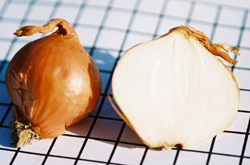 |
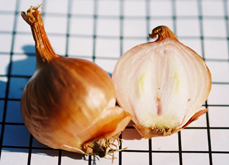 |
||||||||||||||||||||
| Picasso Shallot | |||||||||||||||||||||
| Yellow Moon Shallot | |||||||||||||||||||||
| Share your seed
Once you are satisfied with the quality of your plants and keep saving seeds for a few years, the time comes to start sharing seeds. Become a member of Seed Savers Exchange. www.seedsavers.org/membership By becoming a member ($40 per year membership fee) you can order seed from 700 plus sources. Unfortunately there are only 35 seed savers in Wisconsin and 33 in Illinois ... but none in Kenosha and Racine Counties. We need to change that and have more local gardeners listed in Seed Savers Year Books to make seed available to other local gardeners. This page lists all cultivars that I save - some are available to all (HAS), most are reserved to "listed" SSE members - click here to review the list of cultivars. Please call Seed Savers, become a "non-listed" member (support this no-profit organization) and eventually join me in offering seed as a listed member. Call (563) 382-5990 |
|||||||||||||||||||||
| Wanted: Potato Gardeners
If you'd like to participate with the Kenosha Potato Project - here are your options:
Please join us on Facebook - search for Kenosha Potato Project |
|||||||||||||||||||||
| web page updated: January, 2011 | |||||||||||||||||||||
|
|
|||||||||||||||||||||